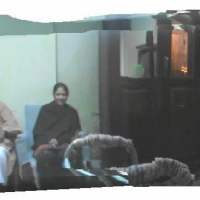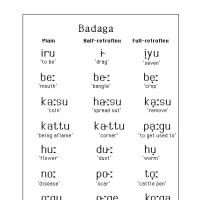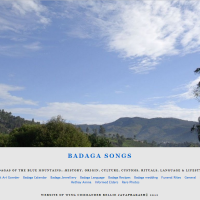SOME POPULAR BADAGA MISCONCEPTIONS
Dear JP,
I have been meaning for some time to send you something that has been troubling me. While it is a great improvement in things that we now have Badagas publishing books about their culture, most of these books seem not to be based on well-established scholarship on South India, but rather personal impressions. Contrary to what Trump might say, in the long run you can’t have alternate histories of a people, some of which are based on critical research and others of which are not. The critical research is what will last while at the same time being modified by further research.
Anyway, it would be nice if you can publish what I have written, in the hope that some rather more critical discussion will take place. I have interviewed some 700-800 Badagas (which I don’t think anyone else has done) and I have tried in my books to distill the essence of their thoughts while acknowledging that there are always differences of opinion depending on what part of a society you are located in. – Paul
The ubiquity of the internet these days, and of Badagas who are perfectly capable of using it, has allowed for a lot more discussion about Badaga matters than used to be the case. And the proliferation of books about the Badagas over the past half-century, when there had been virtually none before that, has given plenty of people food for thought. This is all to the good, of course, and contrasts greatly with the earlier situation. But I would like to point out that some serious yet pervasive misconceptions have arisen in recent years that should be addressed.
The first one to mention, because it is perhaps the oldest, is that it was “western scholars” who decided that the Badagas of the Nilgiris came there from southern Mysore several centuries ago, and that those same scholars decided this because the name of the people means “northerner”. Since I am one of those scholars let me make several point in response.
First of all, from the 1820s onwards, the only writers who showed the slightest interest in Badagas were Westerners. Badagas themselves were certainly unconcerned, no doubt thinking that without literacy they could not have had history. I can mention only two exceptions to this statement. Pandit S.M. Natesa Sastri was a noted Brahmin folklorist (1859-1906) who was reputed to speak 18 languages, Badaga being one of them. Of course, one could not make a decent living being a folklorist in the 19th century, and so Natesa Sastri was employed as a warden in the Ootacamund jail. This gave him ample opportunity to question its Badaga inmates, of whom there apparently were several dozen. As a result of these investigations he published several articles in the Madras Christian College Magazine that are full of valuable and highly accurate information, including verbatim prayers and other samples of the Badaga language. It is of course a great regret that he never made his findings more accessible. The other exception to my statement about Western scholars was a Badaga, M.K. Belli Gowder of Accanakal (Achchanekallu), who early in the 20th century collected a great deal of factual information about the folklore; but he kept it all in notebooks and published almost nothing except for several letters in the South of India Observer. These two writers aside, Indians have shown no interest in Badaga culture until quite recently.
The second point I need to emphasize is that Western scholars never made up their identification of the Badaga homeland in southern Mysore: THIS WAS WHAT TRUSTED BADAGA ELDERS TOLD THEM. In my own research I was told by numerous elders, from 1962 onwards (in other words, by people born around 1900 or just before), that the names of some of the ancestral villages were still known; and they dictated to me Accalli, Agasvadi, Belladi, Gundulupete, Hasanuru, Honnahalli, Jakkalli, Kakkadur-Karahalli, Kavaspadi, Kongahalli, Sulur, and Urigaddige. All of these places (except Hasanuru) lie within a very restricted area not far from Nanjurugudi, a pilgrimage centre which Badaga informants regularly visited because, even in the 19th century, they claimed it was their ancestral home. None of the above sentences were made up by me: I am simply reporting what reliable elderly informants told me half a century ago. Why would I falsify this matter, and why would they lie about it? Ever since the 1820s Europeans have occasionally been asking Badagas where their ancestors had come from, and always got answers along these lines. Even Father Fenicio, visiting Kunda in 1603, met Badagas who told him they lived in three villages and had come from the plains to the north.
Another point of contention arises over the very name “Badaga”. We are all agreed it is a Kannada word originally, and means “northerner” or “from/in the north”. But this apparently has led one modern Badaga writer into real confusion. I have not read his book because my Tamil is pretty hopeless these days, but Sivaji Raman’s book Badaga Samudayam, as reported in this website, seems to make wild and totally unsubstantiated claims about how “Badaga language finds extensive mention in old – purana – Tamil literature like Tholkappiam”. This is nonsense because, first, the language of the Nilgiri Badagas did not have any separate existence from Kannada until several centuries ago; and secondly, the “Badaga” referred to here were people who, from a Karnataka perspective, were indeed “northerners” but were people who we know spoke Telugu! In short, they had nothing at all to do with the Nilgiri peoples, as they were living in what we now know as Andhra. The Tolkappiyam dated to around the 3rd century AD, a time before anything is known about any Nilgiri peoples, and some 1400 years before Badaga became established as a Nilgiri language. That great Tamil work was in fact referring to the early Telugu language. For scholars of Dravidian literature this fact about “Badagas” has been common knowledge since at least the 19th century, so it is sad to find people who are not really familiar with Indian philology still making this baseless claim about mention in the Puranas in the 21st century.
There have been a few Badagas who in recent years have claimed a great antiquity for the Badaga occupance of the Nilgiris. One person recently wrote on a website that the Badagas had been on these hills for “8000 years”. Not only is this totally preposterous, as we know nothing about the names or locations of ethnic groups anywhere in India prior to the adoption of writing, least of all on the Nilgiris; but such ludicrous claims just serve to make Badaga history laughable to any serious scholars of South India. There were Mesolithic cultures in parts of India 8000 years ago, but even if archaeologists eventually demonstrate presence of humans here on the Nilgiris even 1000 or 2000 years ago, there would still be no evidence that the people involved were Badagas in any sense. In fact, the earliest Nilgiri occupants were probably Kurumbas, because (a) there are some Badaga hattis with Kurumba placenames, as the Kurumbas had already left, and (b) Kurumba magic seems to be identical with Buddhist magic, which otherwise disappeared from South India around 1000 years ago, along with Buddhism and Jainism generally.
I don’t doubt that IF evidence were to show a greater antiquity for the Badaga occupance of these hills it might bolster some current political arguments. But the fact remains that there is a great deal of evidence for the Badagas having arrived 4-5 centuries ago and virtually none for any earlier arrival. The relevant evidence has been examined closely by a number of anthropologists and historians over the years, so it is not just a matter of one man’s “opinion”. Indeed, old Toda and Kota folktales don’t even mention the presence of Badagas. I need hardly add that creating imagined or false histories of the Badagas that are not based on a scrutiny of all available facts will be an irreparable disservice to future generations, who are likely to ask more searching questions about their ancestry.
Though I may not agree with some of the views, specially on the origin of Badagas, of Prof. Paul Hockings, there is no denying the fact that he has spent considerable amount of time and efforts in his research on and of Badagas and brought them out in his books. Also, there is no denying the fact that some Badagas had migrated from the plains of Mysore about four/five ceneturies ago.
Can it be that Badagas existed in a very few hattis in the Nilgiris for a long, long time much before this migration, a view I strongly believe in?
Rao Bahadur Hubbathalai Bellie Gowder, (he could speak eleven languages), a contractor (he was called Bellie Maistry) who was instrumental in laying the mountain railways from Mettypalayam to Ooty, presented a memorandum, listing Badagas as one of the original tribes of the blue mountains (The Nilgiris) along with Thodas, Kothas, Kurumas and Irulas, to the Governor of Madras in 1923 who visited Hubbathai hatti on his personal invitation. I have some of the photos taken on that occassion.
Is it correct that Thodas and Kothas have not mentioned Badagas in their folktales ? What exactly is the origin of these two tribes?
Do Thoreyas and Odeyas really consider themselves as Badagas? Are their traditions, rituals , customs and culture, specially marriage and funeral rites same as other Badaga groups (which have mingled so much that you cannot distinguish a Gowda from a Haruva, Adhikari or Kannakka)? In one of the funerals at Sakkalatti, I noticed some changes that are different from other ‘main stream’ hattis. Incidentally, I was told that, in the Kattery group of hattis (Lingyats/Lingakuttis) have decided to accept Basavanna as superior to Shiva. Marriages with Mysore brahmins(non Badagas) is still common in these hattis.
Unless we, Badagas, undertake extensive research to an alternative Prof.Paul Hockings’s views with scientific proof, our contention will remain as personal impressions, as he says.
Critical discussions are most welcome.
Wing Commander Bellie Jayaprakash

























 Mookuthi
Mookuthi  Chinna
Chinna 






 ==
==


![Seemae [See'may] & Morae [Mo'ray] (relationship)](https://i0.wp.com/badaga.wordpress.com/files/2008/11/nakku-betta1.jpg?resize=200%2C200)









































